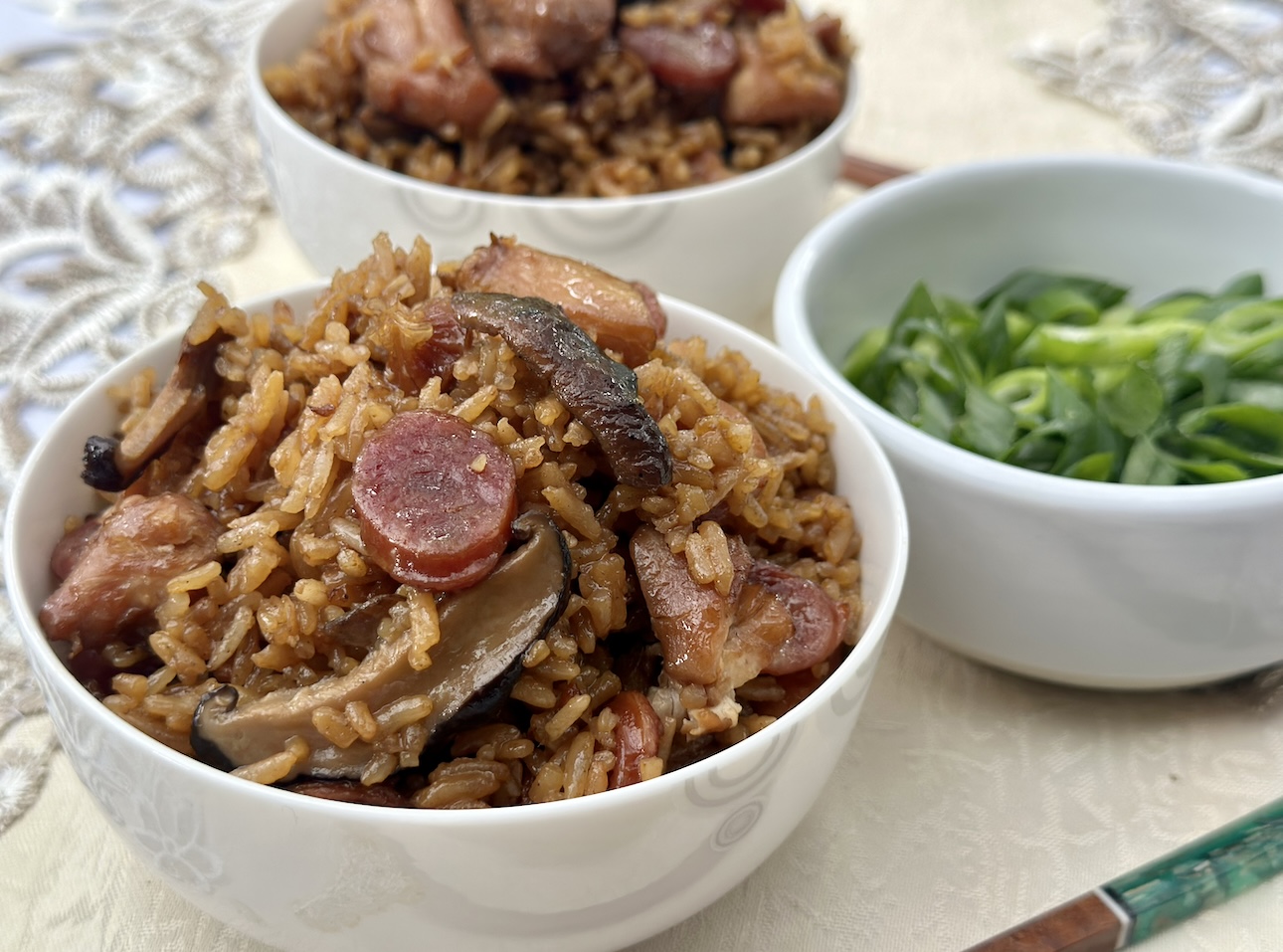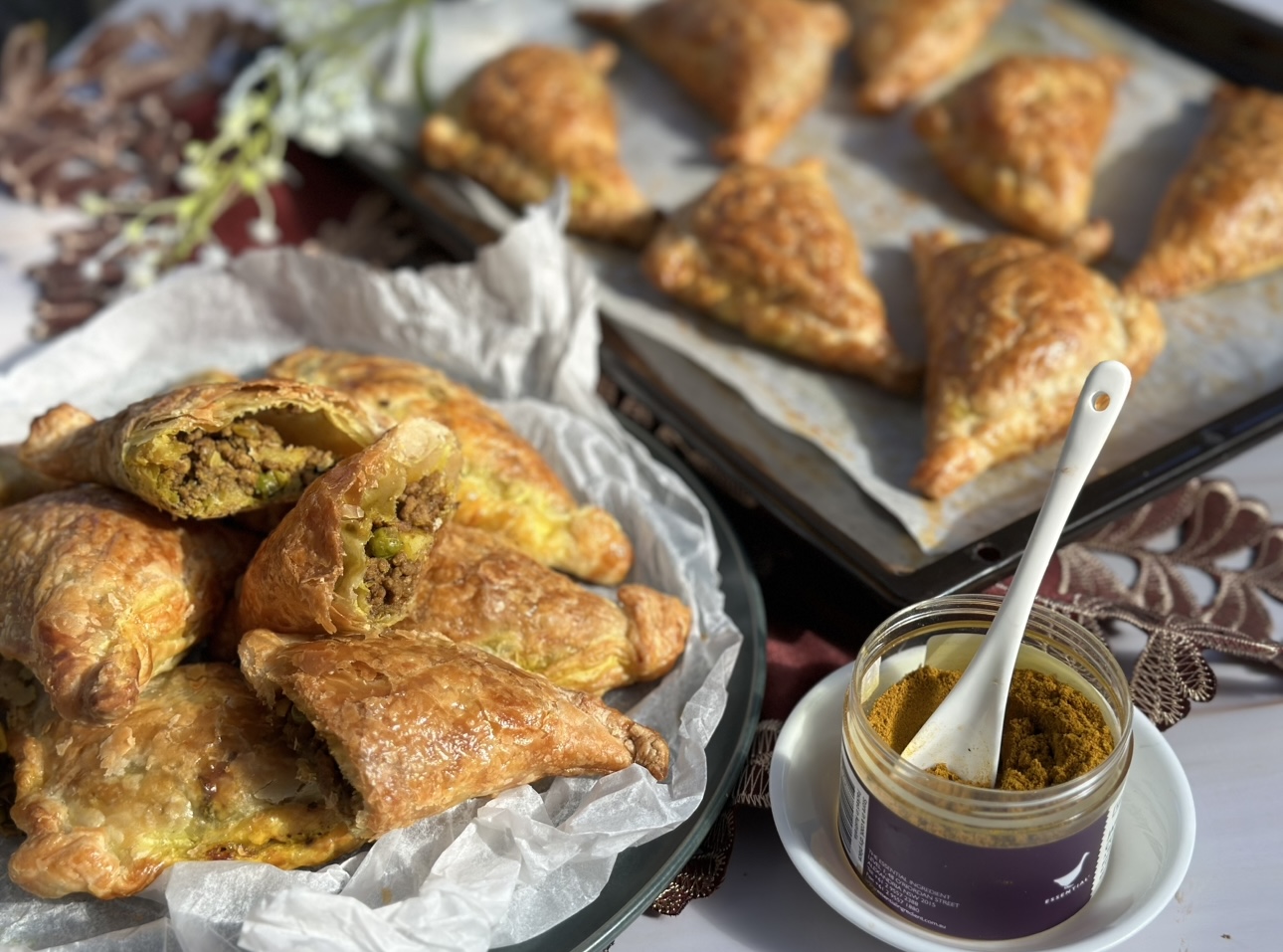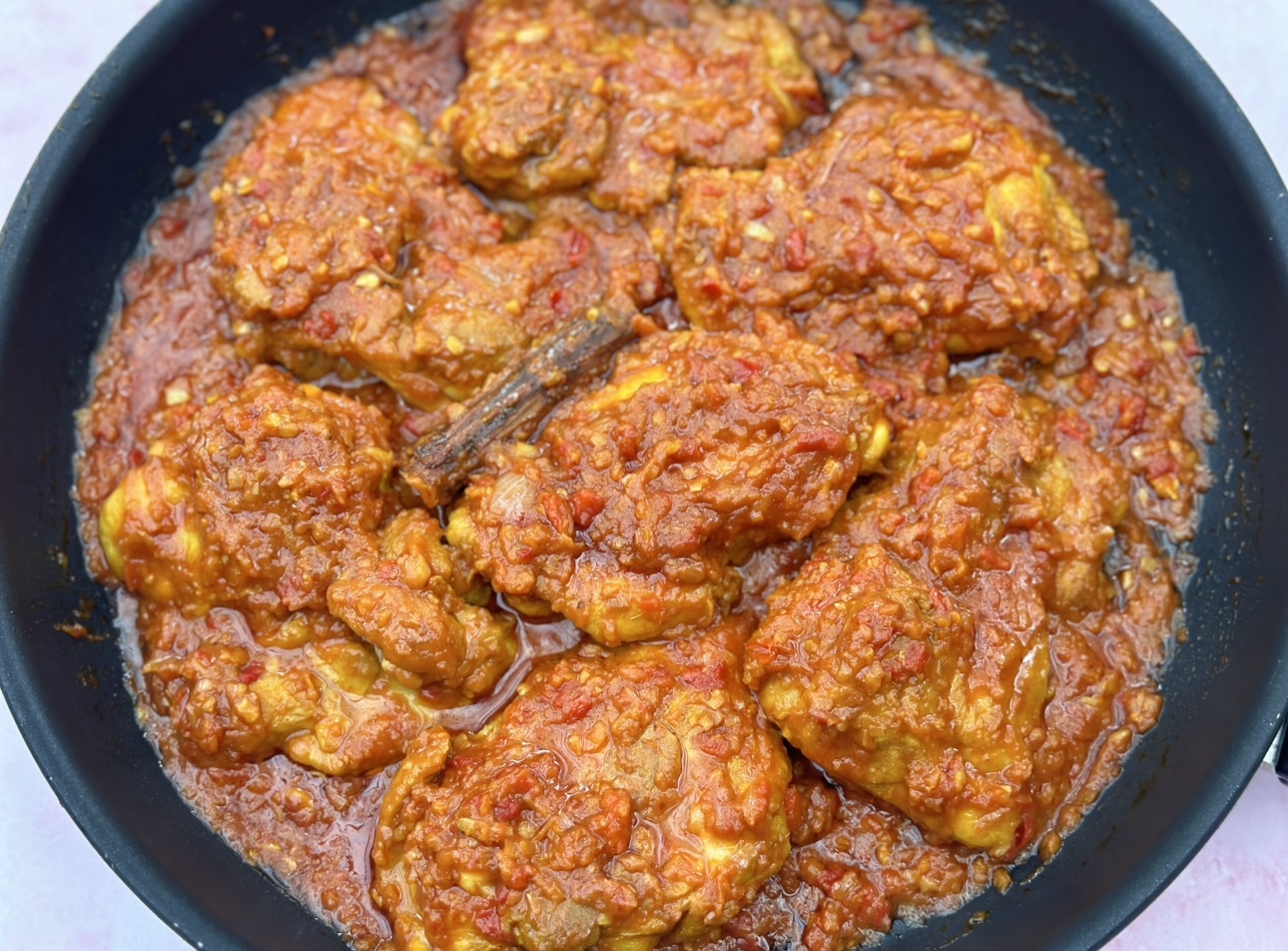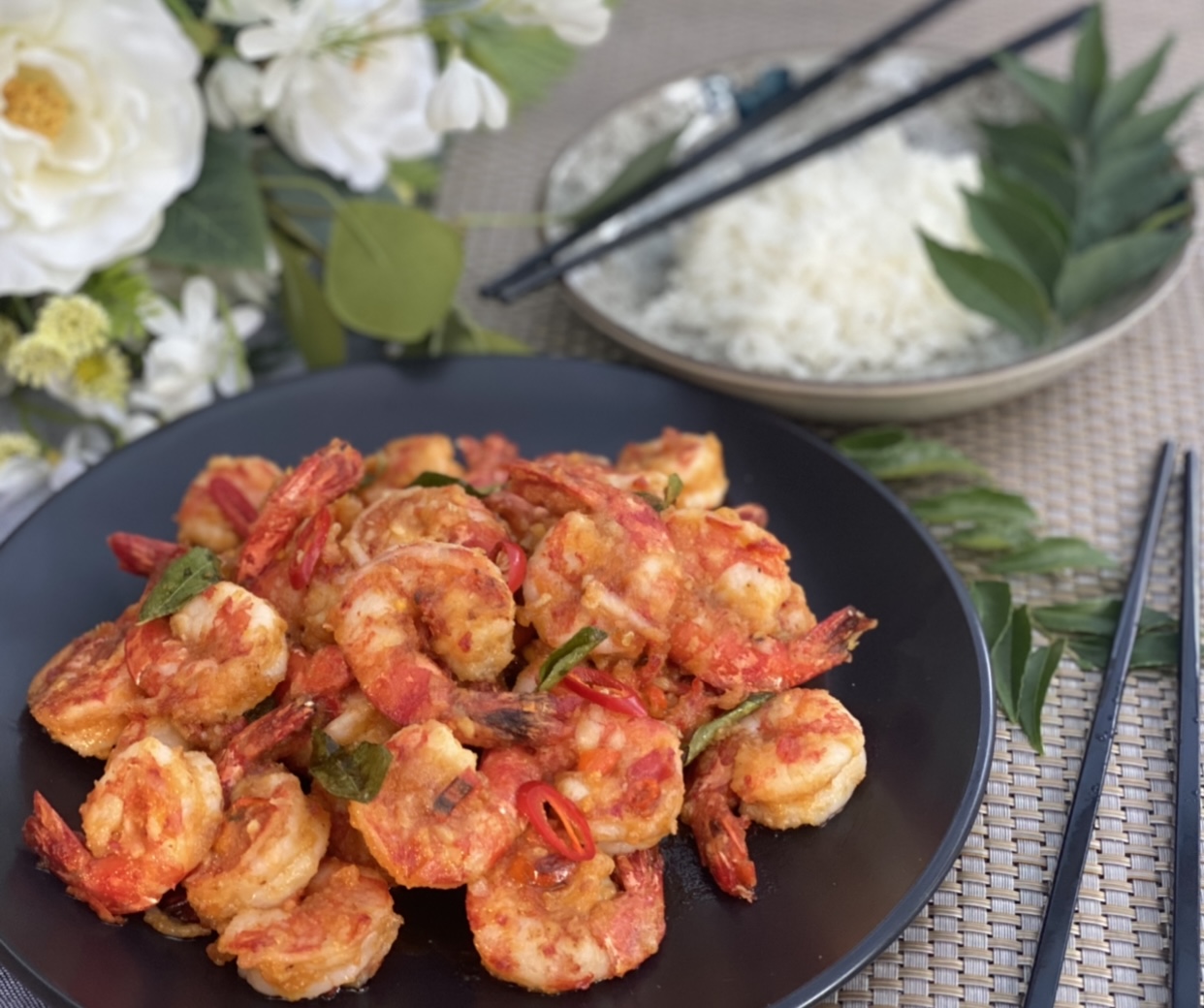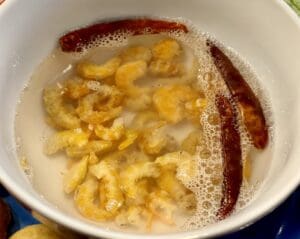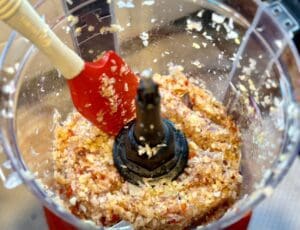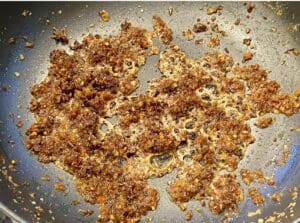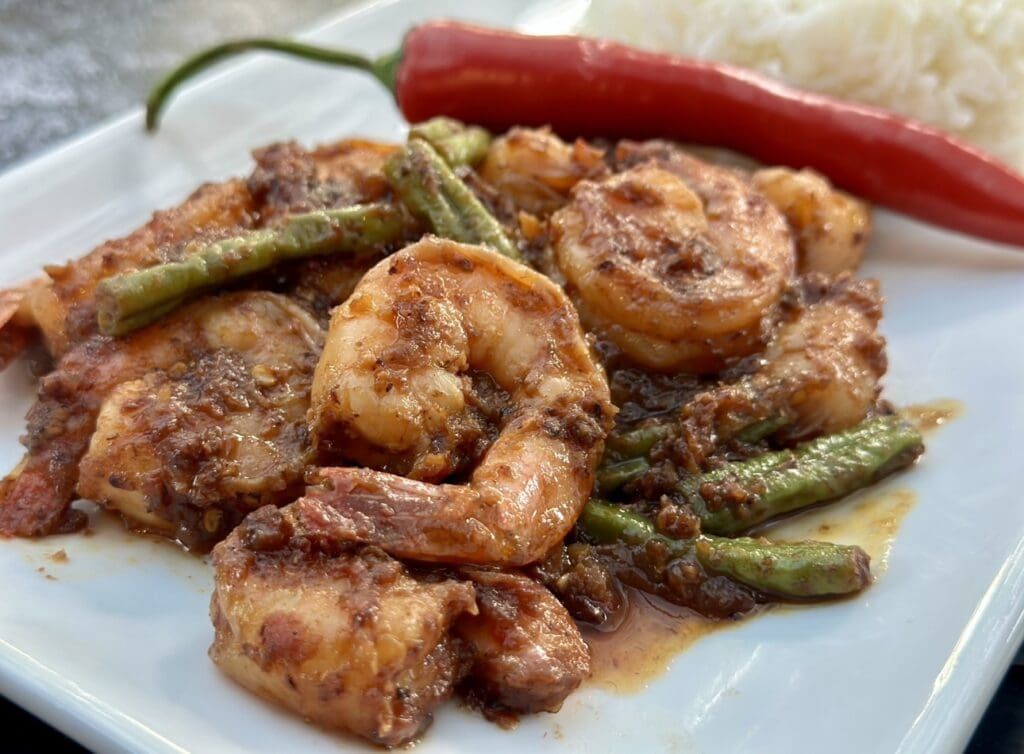
This Prawn Sambal has juicy prawns covered in spicy sambal made with chillies, dried shrimp, garlic, shallots, ginger, tamarind and belachan
Homemade Prawn Sambal?
Do you remember those large succulent prawns smothered in a deliciously spicy sambal on your last visit to a Malaysian or Indonesian restaurant? Such deep, tantalising and complex flavours, there’s no way we could recreate this exotic dish at home!
Oh yes, we can! Don’t let the exotic ingredients in this Prawn Sambal intimidate you. Why you ask? It’s because ingredient suppliers have made our life easier by giving us shortcuts, like ready to use jarred tamarind puree and pre-roasted belacan. These shortcuts won’t affect the flavours of this dish because you’ll still have a gorgeous aromatic sambal.
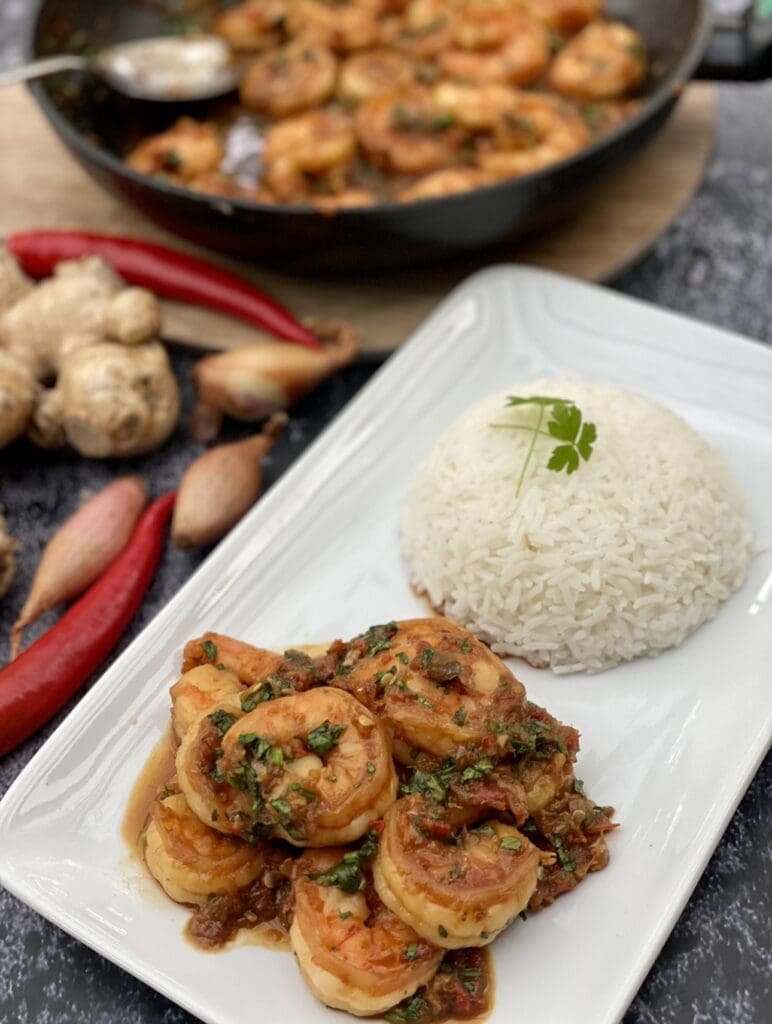
My trusty food processor takes care of the next task by expertly chopping dried chillies, large red chillies, dried shrimp, garlic, shallots, and ginger to make the spicy paste.
Once the spice paste has cooked gently and the oil has separated, we add belacan, tamarind, palm sugar, fresh tomatoes, snake beans, and prawns. See? it’s definitely doable, and what a mouthwatering symphony of flavours it is!
Just a word of warning, though, while sauteing the spice paste you might have a little coughing attack. But don’t worry because this is normal! Even though the prawns were tempting, the pungent smell of spices scared my kitties away from the kitchen 😂
Prawn Sambal
Prawn Sambal is popular in Indonesia, Singapore and Malaysia. This recipe is more reminiscent of the Malaysian Prawn Sambal.
Why do we need to toast belachan?
Belachan is firmer than Thai shrimp paste and is typically sold in small blocks that need to be sliced and toasted before use.
When belachan is toasted, its flavours and aroma get a major upgrade. The process of toasting belachan involves heating it gently until it becomes fragrant and develops a rich, smoky flavour.
I’ve tried toasting belachan once using a frying pan and let’s just say I would never attempt to do it again! The smell in our kitchen was absolutely terrible and it lasted for weeks! I can’t even explain how bad it smelled. A corpse? Perhaps, but that wouldn’t be accurate because I haven’t smelled one before. Oh, if only I knew they sold pre-roast packets of belachan before this!
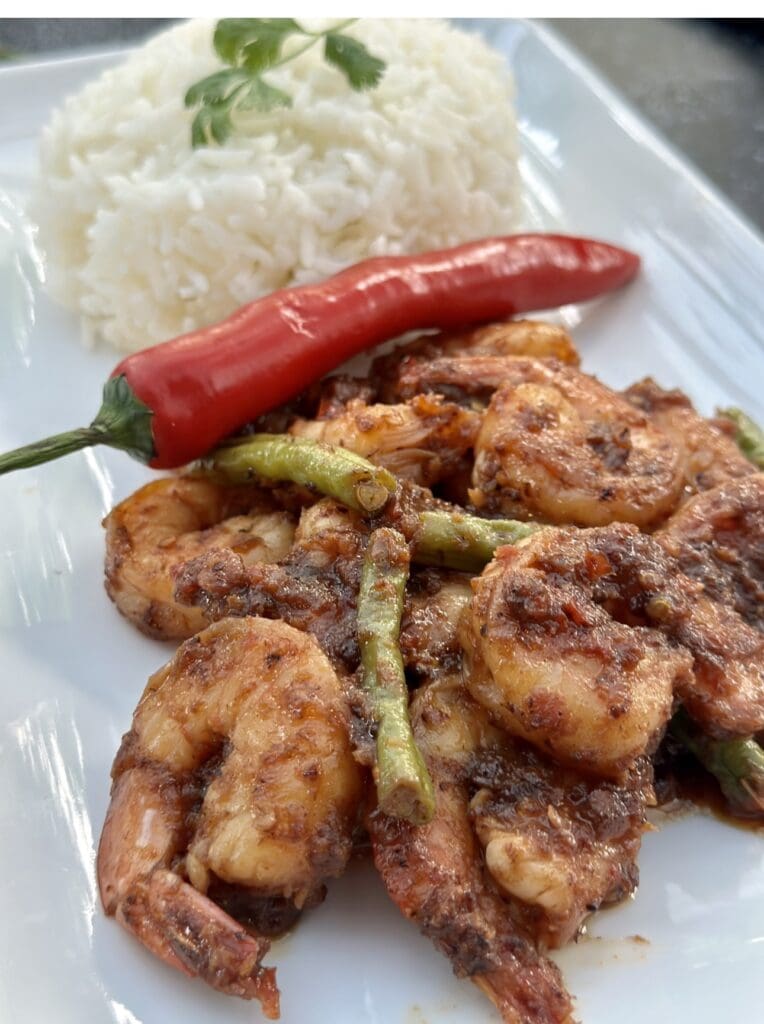
Why does the oil need to separate from the spice paste?
This part involves some patience and can take 10 minutes or longer sauteing the spice paste over low heat. The spice paste will eventually dry up as the water evaporates and you’ll see the oil pool around the edges of the paste. This means the spice paste is now at its peak flavour, so no raw spice taste!
Why do we need to soak the dried shrimps and chillies?
Hydrating the dried shrimps and chillies for 10 minutes or more will make them easier to pound or blitz in the food processor.
More amazing Asian recipes to try at home:
Ingredients for Prawn Sambal

I used frozen raw prawns that were conveniently peeled, cleaned, and deveined before packaging. Thaw the frozen prawns fully in the fridge, drain any extra water, and pat them dry before using. We need 700gm / 1.5 lb of prawn meat (which excludes any shells) for this recipe.
Dried shrimp (prawns) – These little shrimps are flavour bombs! Just like shrimp paste, it adds loads of savoury goodness and complexity to a dish. Pick up a packet from your Asian grocer.
Whole dried chillies – Dried chillies have different heat levels, ranging from mild to ultra spicy, depending on the brand. It’s best to have a little taste to see how hot they are before using them. This way you can judge how many to use and adjust to your liking. If you’re unable to find dried chillies, use fresh small red chillies such as Bird’s-eye. Supermarkets stock dried chillies in their international section. If not, most Asian grocers supply them.
Roasted belachan (belacan or shrimp paste)
Belachan is made using fermented shrimp or krill. It smells pungent and awful! However, shrimp paste adds deep and wonderful flavour to dishes. If you’re brave enough, you could roast your own, but if you can bear the smell like me, opt for the roasted belachan. Most Asian grocers have raw and roasted belachan available.
Snake beans – Like their name, these beans are stringy and long. I got mine from an Asian grocer, but I’ve seen them sold at my local fruit and veggie grocer. If you’re unable to find them, swap them for regular green beans.
Shallots (eschalot or French shallots) – Shallots look like small brown onions but are skinny and oval-shaped. They’re difficult to peel and are more expensive than other types of onions. Shallots have a mild flavour, but you could swap them for equal amounts of brown or red onions.
Tamarind puree – (tamarind concentrate or paste) has a distinct sweet and sour taste. The firm blocks that have seeds must be soaked and strained prior to use. For convenience, I like to use tamarind in puree or paste form. You can find tamarind in Asian grocers or the international section at supermarkets.
Subscribe to 3CatsFoodie’s FREE Newsletter

For the latest recipes and other fun stuff!
How to make Prawn Sambal
Step-by-step guide with photos
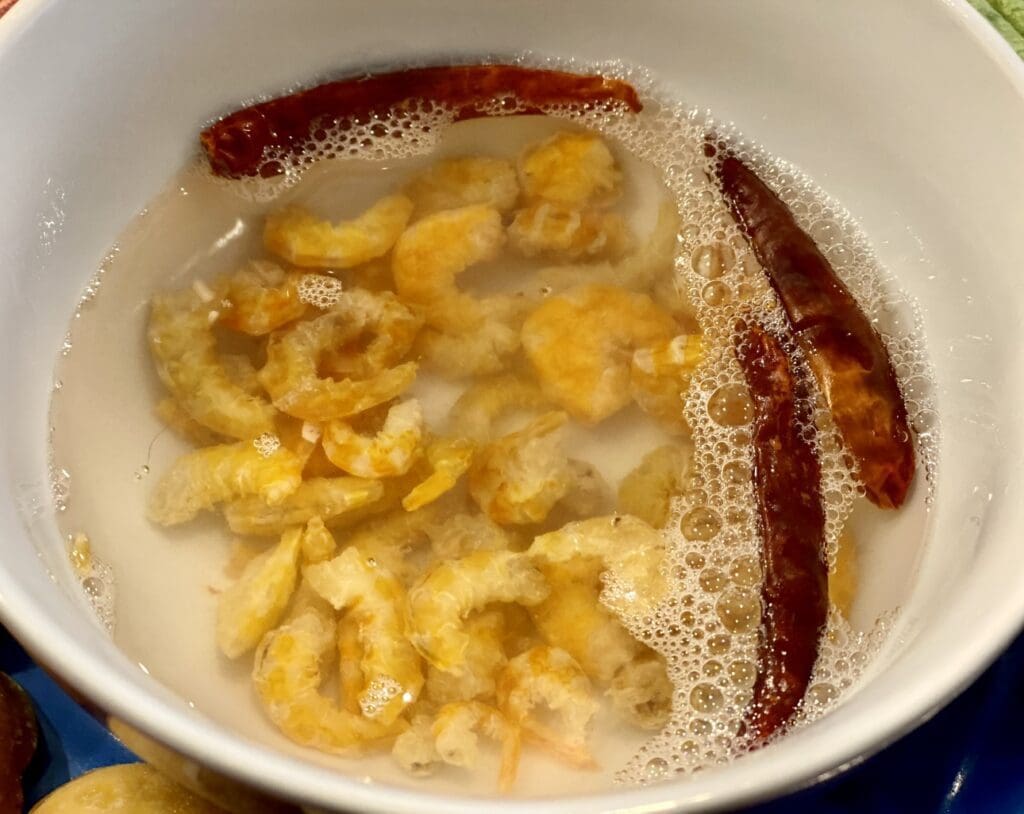
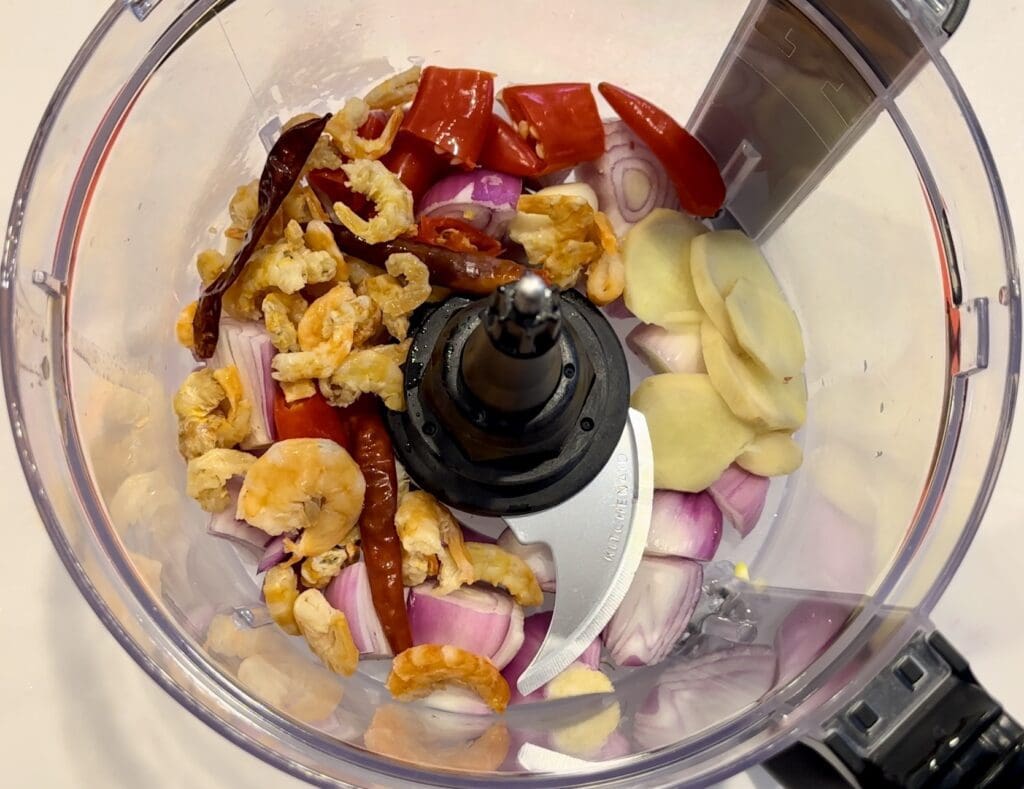


Submerge the dried shrimps and dried chillies in boiling water, then let them sit covered for 10 minutes.
For the spice paste – Squeeze out any excess water from the dried shrimps and chillies, then transfer them into a food processor. Add in the remaining spice paste ingredients, then blitz the ingredients together. You may need to stop the processor to scrap down the sides of the bowl. Blitz until the ingredients are finely chopped and have a paste-like consistency. Alternatively, you could use a mortar and pestle to make the spice paste.
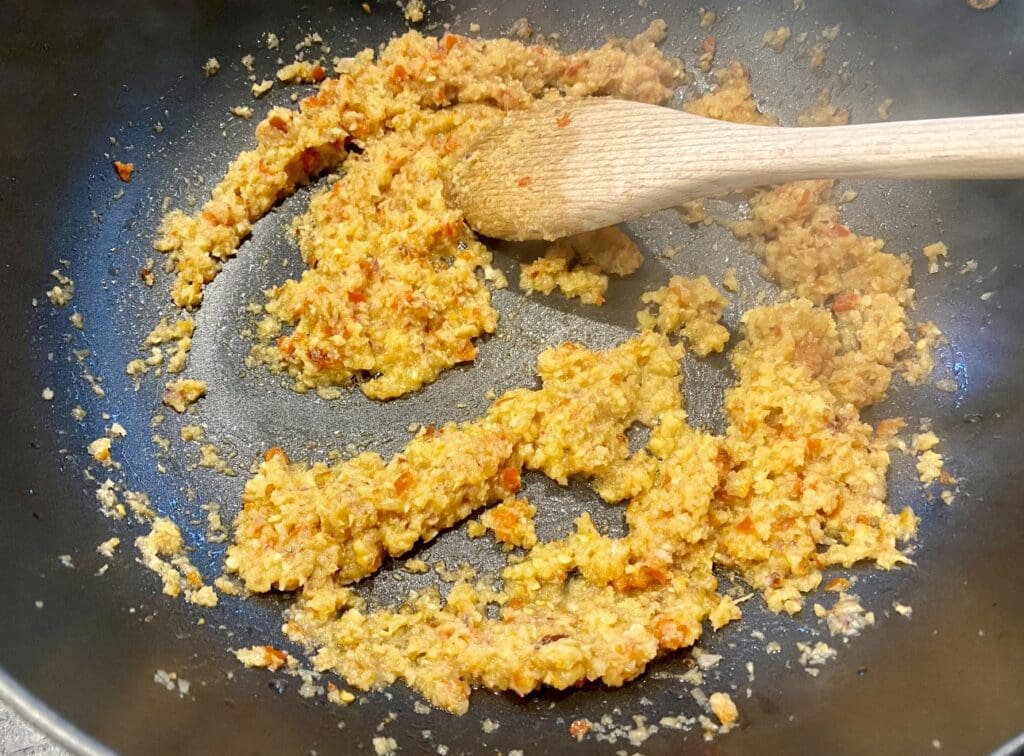
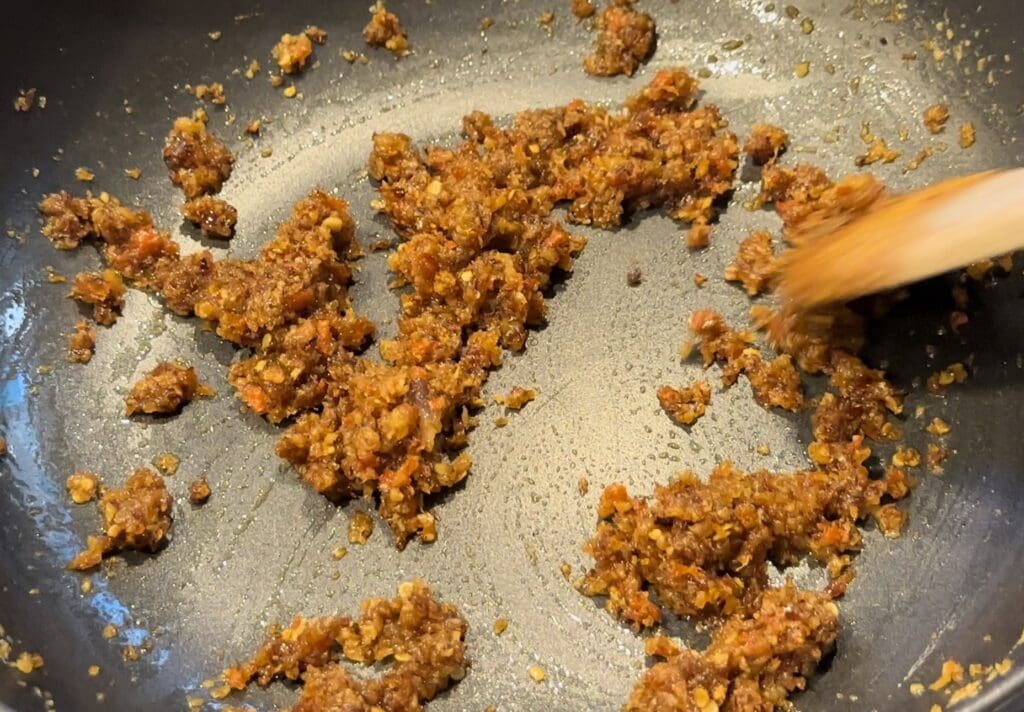
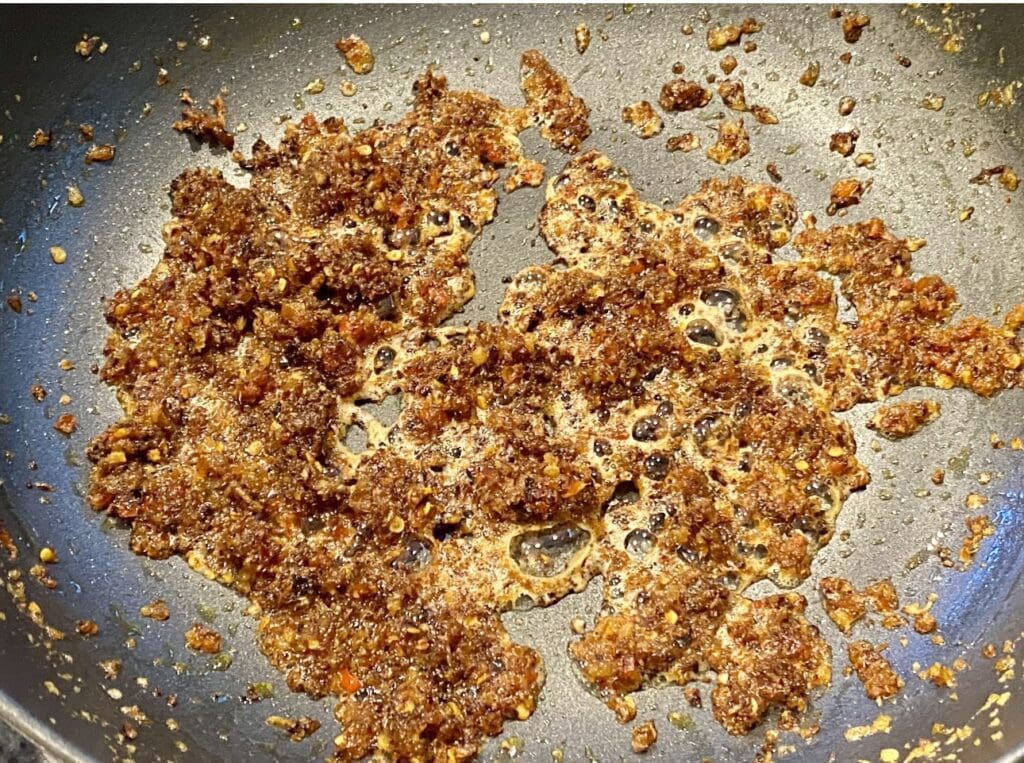
Heat oil over medium-low heat in a large frying pan or wok, then add the spice paste. Stir the paste so it doesn’t catch on the bottom and burn. If the spices burns, the sambal may taste bitter. Cook and regularly stir the paste until it turns darker, and the oil separates. This process may take up to 10 minutes or longer.
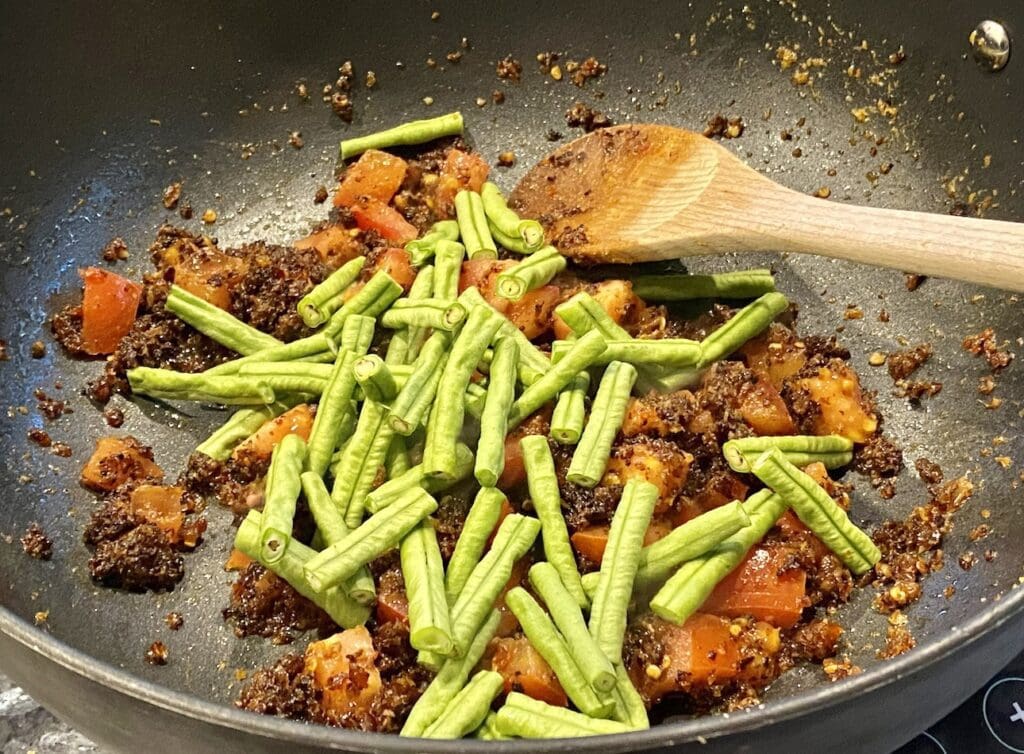

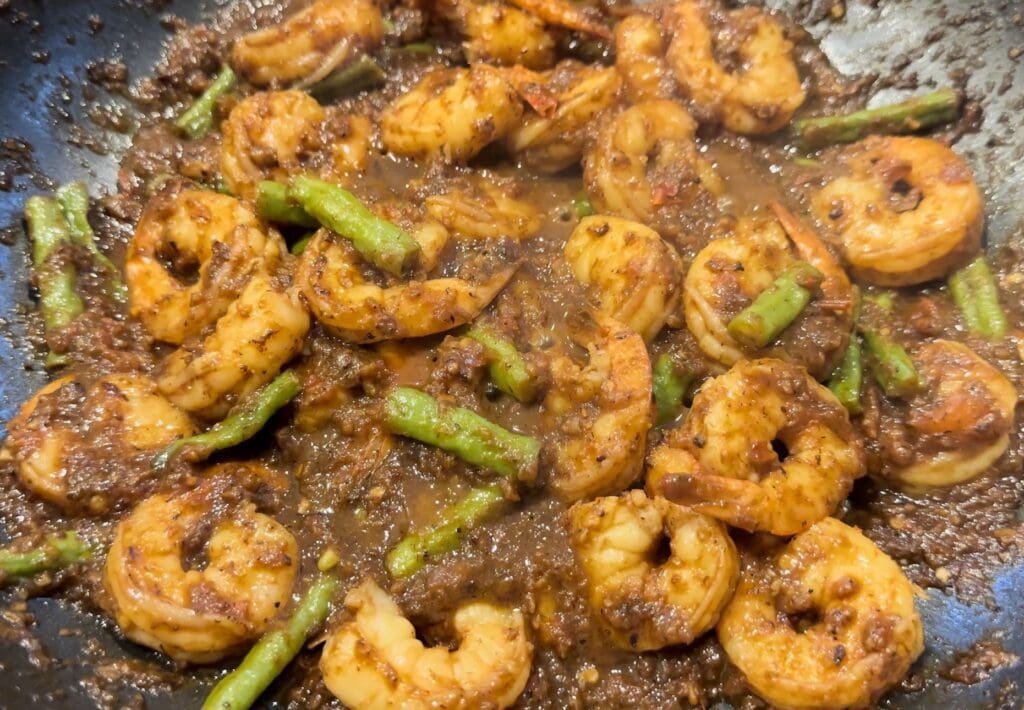

Add the belachan, fish sauce, and tamarind to the mixture, then cook for 60 seconds. Loosen the mixture by stirring in 1/4 cup of water. Increase the heat medium-high, then add in the palm sugar, tomatoes and beans, cook for 2 minutes. Place in the prawns and cook for a couple of minutes or until the prawns are no longer opaque.
To make the sambal saucier, gradually add more water until you have the desired consistency. Have a taste and adjust the sambal to your liking by adding salt, sugar, chillies or tamarind. Serve your Prawn Sambal with rice and enjoy!
How to store Prawn Sambal
Allow the Prawn Sambal to cool completely at room temperature, then transfer it into a sealed container and store in a fridge for up to 2 days.
I’ve used a third-party application to calculate the calories and nutritional information, so please use this as an approximate guide only.
Cooking measurements are in Australian standard spoon and cup measurements. For specific details and conversions, visit our Australian Cooking Measurements page.
I would love your feedback and support if you made this recipe. To do this, please rate this recipe and provide a comment by scrolling down this page or by clicking that green circle on the bottom left. An email address is necessary to prevent spam, but it won’t be published. I would also love to see your dish, so don’t forget to tag me on my Instagram account ‘3catsfoodie’
Cheers – Cat T
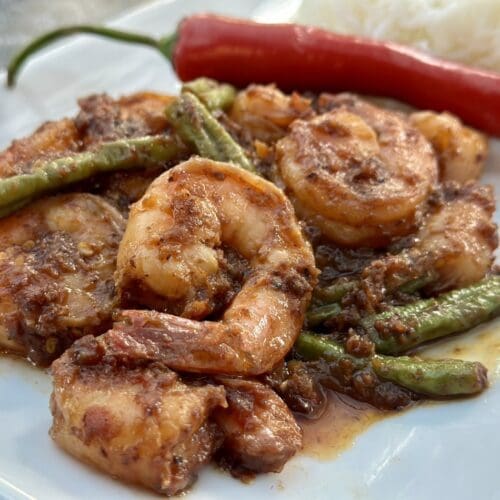
Prawn Sambal (Sambal Udang)
Video
Ingredients
- 700gm / 1.5lb raw prawns (peeled and cleaned) (NOTE 1)
- ⅓ cup (80ml / 2.7floz) peanut oil
- 10gm / 0.3 oz toasted belachan/ belacan (NOTE 2)
- 1 tbsp fish sauce
- 1 tbsp tamarind paste or puree (NOTE 3)
- 2 tbsp (40gm / 1.4 oz) palm sugar (or brown sugar)
- 1 medium tomato (roughly diced)
- 8 snake beans (chopped in 4cm / 1.5in) (NOTE 4)
FOR THE SPICE PASTE
- 30gm / 1 oz) dried shrimps (NOTE 5)
- 2 to 5 dried chillies (adjust heat to your liking) (NOTE 6)
- 3 garlic cloves
- 15gm / 0.5oz ginger (peeled and sliced)
- 150gm / 5.3oz shallots (roughly diced) (NOTE 7)
- 2 large red chillies
Instructions
- Submerge the dried shrimps and dried chillies in boiling water, then let them sit covered for 10 minutes.

- For the spice paste – Squeeze out any excess water from the dried shrimps and chillies, then transfer them into a food processor. Add in the remaining spice paste ingredients, then blitz the ingredients together. You may need to stop the processor to scrap down the sides of the bowl. Blitz until the ingredients are finely chopped and have a paste-like consistency. Alternatively, you could use a mortar and pestle to make the spice paste.

- Heat oil over medium-low heat in a large frying pan or wok, then add the spice paste. Stir the paste so it doesn't catch on the bottom and burn. If the spices burns, the sambal may taste bitter. Cook and regulary stir the paste until it turns darker, and the oil separates. This process may take up to 10 minutes or longer.

- Add the belachan, fish sauce, and tamarind to the mixture, then cook for 60 seconds. Loosen the mixture by stirring in 1/4 cup of water. Increase the heat medium-high, then add in the palm sugar, tomatoes and beans, cook for 2 minutes. Place in the prawns and cook for a couple of minutes or until the prawns are no longer opaque. To make the sambal saucier, gradually add more water until you have the desired consistency. Have a taste and adjust the sambal to your liking by adding salt, sugar, chillies or tamarind. Serve your Prawn Sambal with rice and enjoy!


